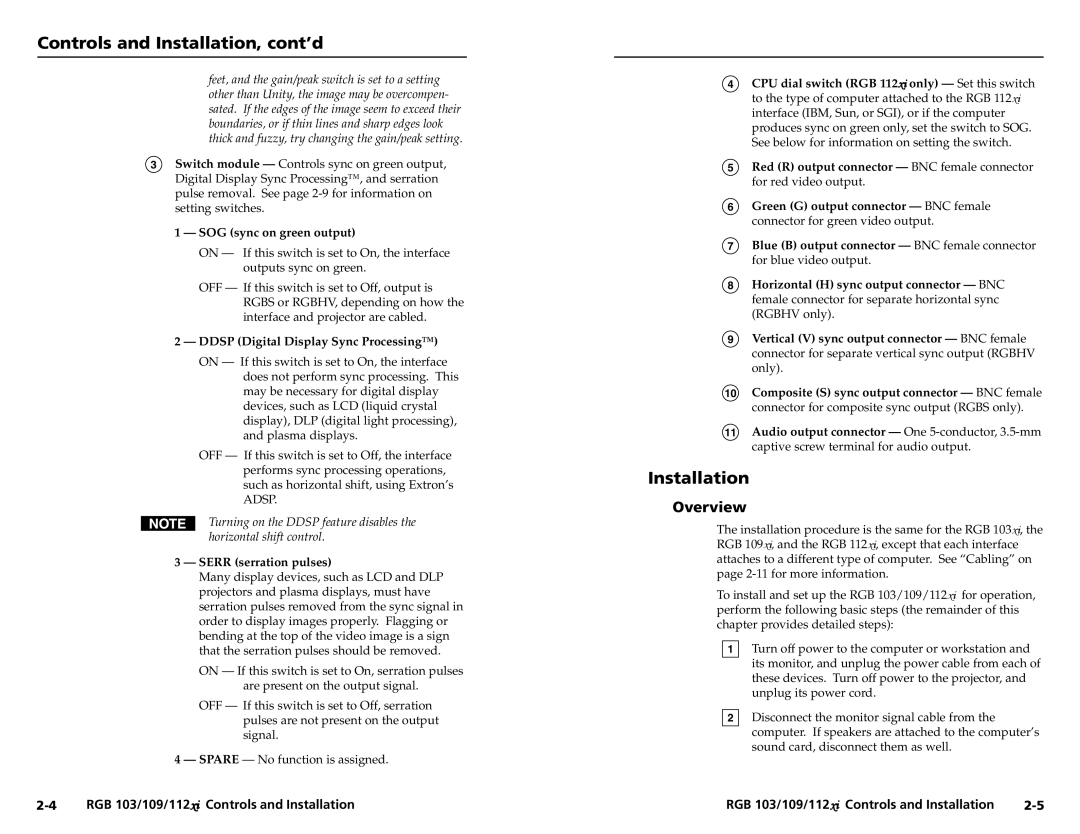
Controls and Installation, cont’d
feet, and the gain/peak switch is set to a setting other than Unity, the image may be overcompen- sated. If the edges of the image seem to exceed their boundaries, or if thin lines and sharp edges look thick and fuzzy, try changing the gain/peak setting.
3Switch module — Controls sync on green output, Digital Display Sync Processing™, and serration pulse removal. See page
1 — SOG (sync on green output)
ON — If this switch is set to On, the interface outputs sync on green.
OFF — If this switch is set to Off, output is RGBS or RGBHV, depending on how the interface and projector are cabled.
2 — DDSP (Digital Display Sync Processing™)
ON — If this switch is set to On, the interface does not perform sync processing. This may be necessary for digital display devices, such as LCD (liquid crystal display), DLP (digital light processing), and plasma displays.
OFF — If this switch is set to Off, the interface performs sync processing operations, such as horizontal shift, using Extron’s ADSP.
Turning on the DDSP feature disables the horizontal shift control.
3 — SERR (serration pulses)
Many display devices, such as LCD and DLP projectors and plasma displays, must have serration pulses removed from the sync signal in order to display images properly. Flagging or bending at the top of the video image is a sign that the serration pulses should be removed.
ON — If this switch is set to On, serration pulses
are present on the output signal.
OFF — If this switch is set to Off, serration pulses are not present on the output signal.
4 — SPARE — No function is assigned.
4CPU dial switch (RGB 112xi only) — Set this switch to the type of computer attached to the RGB 112xi interface (IBM, Sun, or SGI), or if the computer produces sync on green only, set the switch to SOG. See below for information on setting the switch.
5Red (R) output connector — BNC female connector for red video output.
6Green (G) output connector — BNC female connector for green video output.
7Blue (B) output connector — BNC female connector for blue video output.
8Horizontal (H) sync output connector — BNC female connector for separate horizontal sync (RGBHV only).
9Vertical (V) sync output connector — BNC female connector for separate vertical sync output (RGBHV only).
10Composite (S) sync output connector — BNC female connector for composite sync output (RGBS only).
11Audio output connector — One
Installation
Overview
The installation procedure is the same for the RGB 103xi, the RGB 109xi, and the RGB 112xi, except that each interface attaches to a different type of computer. See “Cabling” on page
To install and set up the RGB 103/109/112xi for operation, perform the following basic steps (the remainder of this chapter provides detailed steps):
1Turn off power to the computer or workstation and its monitor, and unplug the power cable from each of these devices. Turn off power to the projector, and unplug its power cord.
2Disconnect the monitor signal cable from the computer. If speakers are attached to the computer’s sound card, disconnect them as well.
RGB 103/109/112xi Controls and Installation | RGB 103/109/112xi Controls and Installation |
